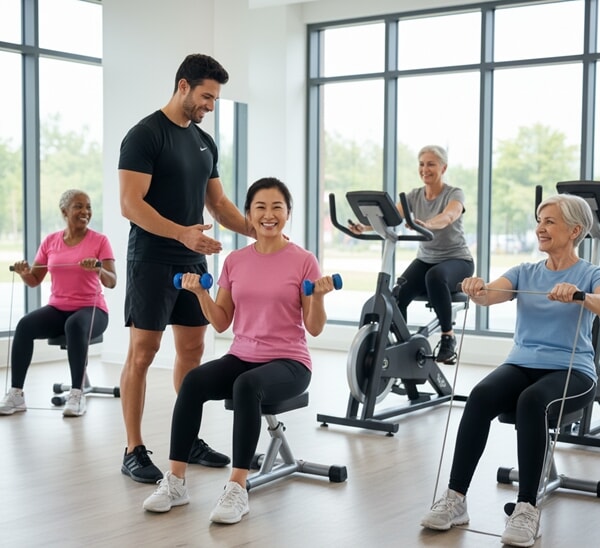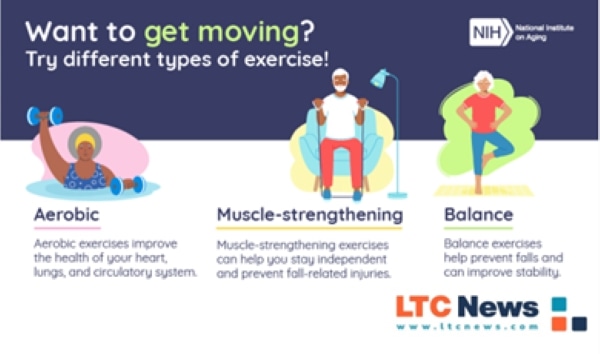Certified Trainers for Older Adults Provide Safe, Effective Fitness for Improved Quality of Life

You’ve probably noticed it. Workouts that once felt easy now take more recovery time. The small aches last longer. Balance feels a little shakier. When you’re over 40 — or helping your parents stay active in their 60s, 70s, or beyond — exercise isn’t as simple as it used to be.
Yet, staying active is one of the most powerful ways to maintain independence. According to the U.S. Census Bureau, about 10,000 Americans turn 65 every day. This means more adults than ever need fitness programs designed to keep them moving safely for years to come.
Certified trainers who specialize in senior fitness understand exactly how aging affects your muscles, bones, balance, and endurance, and how to create workouts that are both safe and effective.
Physical activity is one of the most important things older adults can do for their health. Being active can help you keep doing the things you enjoy and stay independent as you age. — National Institute on Aging.
Why Certification Matters
Senior fitness isn’t just “regular fitness, but slower.” Senior fitness trainers are specially trained to work with older adults. They complete a rigorous program focused on the unique needs, abilities, and safety concerns of people as they age. This means your trainer knows how to create safe, effective workouts that help you stay strong, improve balance, and maintain your overall health and independence.
Trainers certified in older-adult fitness complete rigorous coursework covering:
- Health status assessments: They review your medical history, medications, and mobility limitations before you begin.
- Age-appropriate exercise design: They know how to reduce fall risk, improve bone density, and preserve cardiovascular health.
- Safety-first approach: They modify workouts based on energy levels, balance, and preexisting conditions.
Organizations such as the American Council on Exercise (ACE) and the National Academy of Sports Medicine (NASM) offer senior fitness certifications. These programs educate trainers on the anatomical changes associated with aging, safe movement patterns, and motivational techniques for older adults.
This training matters for you. A certified trainer can reduce your risk of injury, speed your recovery, and make exercise something you look forward to instead of fear.
The Core Pillars of Senior Fitness
Certified trainers will guide you through four essential areas. Each targets the natural changes in your body as you age — and when combined, they’re powerful tools for staying independent:
- Strength training: Lifting light weights or using resistance bands helps maintain muscle mass and bone density, thereby preventing fractures.
- Balance training: Simple drills, such as heel-to-toe walking or standing on one foot, can reduce the risk of falls.
- Flexibility and mobility: Gentle stretching or yoga keeps your joints moving and reduces stiffness.
- Low-impact cardio exercises, such as brisk walking, swimming, or cycling, improve heart health without overloading joints.
By focusing on these areas, you’ll be able to keep doing everyday tasks — from climbing stairs to carrying groceries — with greater ease and confidence.
Advanced Techniques and Special Considerations
As you or your parents age, health challenges like joint replacements, heart disease, or post-surgical recovery become more common.
Certified trainers know how to adapt:
- Joint and implant protection: Resistance training programs safeguard knees, hips, and shoulders.
- Safe cardio for heart conditions: Interval-based training can be adjusted for safety and stamina.
- Customized group classes: Modifications enable participants of varying fitness levels to train together safely.
This expertise doesn’t just keep you active — it helps reduce the risk of injury or hospitalization. In the long run, it’s not just about exercise. It’s about independence, quality of life, and staying engaged in your community.
What To Ask When Choosing a Trainer
Not all trainers are created equal. When you’re looking for a senior-fitness specialist, ask:
- Are you certified in older-adult or senior fitness?
- How do you screen for medical conditions or medications before starting?
- What’s your approach to balance, fall prevention, and strength training?
- Do you provide modifications for joint issues, heart conditions, or limited mobility?
A trainer who can confidently answer these questions will help you or your parents feel safe, supported, and motivated.
Fitness Trainers in Long-Term Care Facilities
When you or your loved one moves into a long-term care or assisted living facility, exercise often takes a back seat to medical care and daily routines. Yet movement is critical for maintaining independence and preventing decline.
Many facilities now employ or contract with trainers who specialize in working with older adults, acting as both coaches and advocates for safe, effective activity.
Trainers work hard to help improve overall fitness, thereby enhancing a resident's quality of life.
- Conduct Individual Assessments: Trainers review residents’ medical histories, mobility levels, and therapy notes to design safe, personalized activity plans.
- Lead Group Exercise Classes: From chair yoga to balance drills and light resistance training, these sessions help residents build strength and coordination in a social setting.
- Fall-Prevention Programs: Trainers create balance and gait activities that directly reduce the risk of falls — one of the biggest dangers for older adults.
- Functional Movement Coaching focuses on everyday tasks — such as standing up from a chair, reaching overhead, or walking safely — to make daily life easier.
- Collaborate With Care Teams: Trainers often work alongside nurses, physical therapists, and occupational therapists to ensure exercise programs complement medical care plans.
- Provide Motivation and Companionship: Beyond physical activity, they offer encouragement, a sense of routine, and positive social interaction that can lift residents’ moods.
Why This Matters
Regular, tailored exercise inside a long-term care setting can slow functional decline, boost mood, and improve residents’ confidence in their own abilities. For families, knowing a certified trainer is on staff can be reassuring — it shows the facility values proactive health and independence, not just custodial care.

When residents regain the ability to stand, walk, or simply move with less pain, their independence is restored.
If you’re evaluating a long-term care facility for a loved one, ask whether they offer senior-focused fitness programs and certified trainers. Facilities that invest in specialized exercise support often see fewer falls, faster recoveries, and happier residents.
Search for an assisted living facility and other long-term care facilities by using the LTC News Caregiver Directory - Find assisted living facilities near you.
If your loved one has Long-Term Care Insurance, their policy will pay for extended care at home or in a facility. Be sure to tell the admissions coordinator that your loved one has LTC Insurance.
LTC News partners with Amada Senior Care to provide free claim support with no cost or obligation — File a Long-Term Care Insurance Claim.
If they don't have an LTC policy, but your loved one has a life insurance policy, you could sell it for cash now to cover the costs of long-term care.
You don’t have to settle for slowing down as you age. With the right fitness trainer, you or your loved one can stay strong, steady, and independent. Senior-focused fitness is not just exercise — it’s a proven way to protect your health, reduce your risk of injury, and preserve your freedom as you get older.


